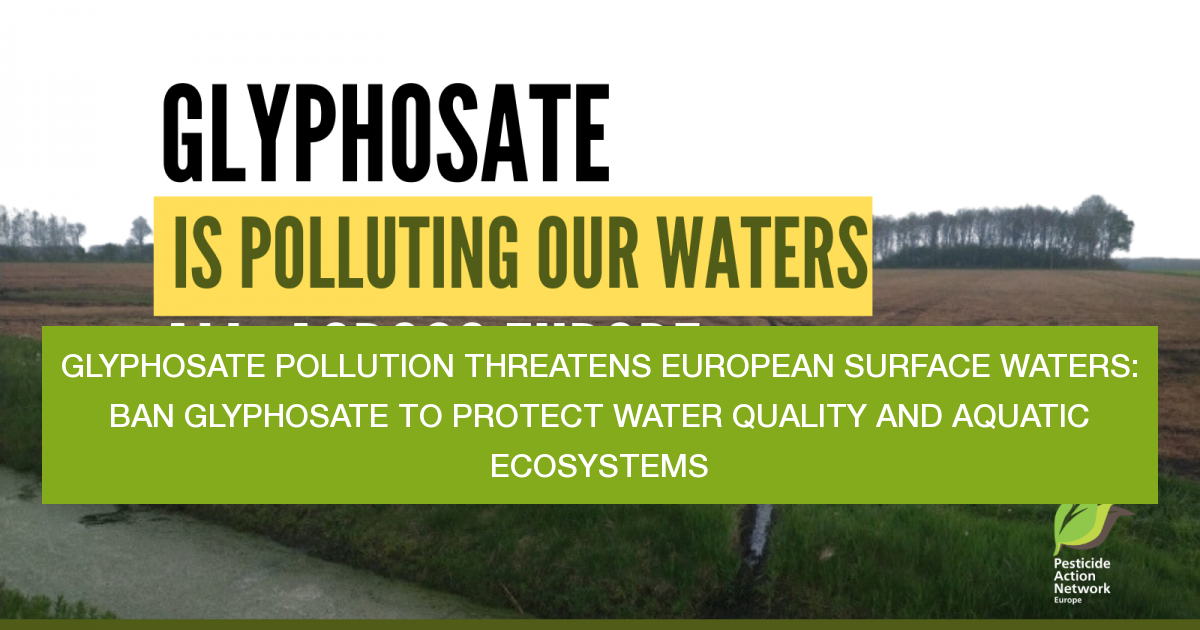Glyphosate and its metabolite AMPA are found in surface waters across 11 out of 12 countries spanning Europe, even during the end of the pesticide application season. From Poland to Portugal, from Belgium to Bulgaria, our waters are polluted by the herbicide. This is the disturbing finding in a new report by PAN Europe and the Greens/EFA Group in the European Parliament. The contamination poses a significant threat to aquatic life and incurs unnecessary costs for European water companies. The fact that the water samples were taken during what is the ‘low season’ in most countries shows the pervasive nature of glyphosate contamination. The study also sheds light on the lack of a European monitoring system for surface water, exposing a critical regulatory gap in safeguarding our water resources.
Glyphosate is everywhere. It is found in human urine, house dust, soils, and surface waters. The presence of glyphosate as a contaminant in aquatic ecosystems raises significant concerns about the quality of water resources and its impact on aquatic species. Both glyphosate and its metabolite AMPA have been identified as posing major risks[1] to aquatic environments.
Exceeding the safety threshold for human consumption in water
Glyphosate and/or AMPA were detected above the limit of quantification of 0.2 μg/L (LOQ) in 17 out of 23 river water samples (74%), from 11 out of the 12 countries. River water samples from Austria, Belgium, Bulgaria, Croatia, France, Germany, Hungary, the Netherlands, Spain, Poland and Portugal were contaminated with at least one of the substances. Only in Slovenia no glyphosate or AMPA were detected. Samples were taken in the second half of October 2022..
Considering that the drinking water safety limit for glyphosate alone is 0.1 μg/L five out of 23 water samples (22%) collected in Austria, Spain, Poland and Portugal contained glyphosate at levels not suitable for human consumption. A sample in Portugal contained 3 µg/L, this is 30 times the drinking water limit.
Gergely Simon, senior chemical officer at PAN Europe said: “These results underline that the current use of glyphosate-based herbicides leads to a widespread and unavoidable exposure to this hazardous substance. A European ban is urgent to protect the quality of our waters and our ecosystems.”
AMPA as a problem itself
Samples from Austria, Belgium, Poland, Spain and Portugal, showed concentrations of glyphosate or the metabolite AMPA above 1 μg/L. Alarmingly, 3 samples had contamination above 3 μg/L. The highest concentration measured was 3.9 µg/L for AMPA in Poland.
Strange enough, AMPA, the main metabolite of glyphosate, is at the moment not considered by the European Commission as a relevant metabolite for drinking water, and the 0.1 μg/L drinking water limit does not apply in many EU countries. This allows high and potentially harmful AMPA concentrations in water.
This is not in line with the recent document ‘Peer Review on glyphosate[2], where EFSA clearly states, that “As regards general toxicity, AMPA and N-acetyl AMPA displayed a similar qualitative and quantitative toxicological profile to glyphosate" and AMPA is more persistent[3] in the environment than glyphosate.
Damage to aquatic ecosystems
Scientific evidence shows that glyphosate and AMPA pose a significant risk to aquatic ecosystems, at the concentrations that PAN Europe’s study found in the environment. Even low levels of glyphosate have been found to impact the growth and development of key aquatic species, from plants and algae to fish and amphibians, indicating the risks of prolonged exposure to the aquatic environment. Glyphosate-based herbicides, which also contain surfactants and other co-formulants are usually even more toxic than glyphosate alone. Continuous exposure to glyphosate-based herbicides not only lowers the water quality but also endangers our ecosystems and their functioning.
Glyphosate has been classified[4] as toxic to aquatic life, with long-lasting effects (Aquatic Chronic 2; H411). There is scientific evidence that justifies a higher classification of aquatic chronic toxicity category 1. According to the European pesticide legislation, pesticide use should not have an adverse impact on human and animal health or to the environment. That includes the most vulnerable, like children and babies, as well as biodiversity and ecosystems.
EFSA identifies data gaps on aquatic toxicity
EFSA’s recent Conclusions on glyphosate identified data gaps[5] in relation to its aquatic toxicity. These data gaps, the independent studies on the impact of glyphosate and AMPA on aquatic life, and our findings regarding the current levels of glyphosate and AMPA contamination of our surface waters indicate that the approval criteria are not fulfilled.
Contacts: Gergely Simon, Senior Chemicals Officer, gergely [at] pan-europe.info, +36 20 252 9212
Notes:
[1] https://www.intechopen.com/chapters/67798
[2] https://www.efsa.europa.eu/en/efsajournal/pub/8164
[3] https://www.ncbi.nlm.nih.gov/pmc/articles/PMC5874776/
[4] https://echa.europa.eu/en/registry-of-clh-intentions-until-outcome/-/dis...
[5] https://www.efsa.europa.eu/en/efsajournal/pub/8164 p23.
“a data gap for addressing the risk to aquatic macrophytes due to contact exposure via spray drift of glyphosate was identified and this resulted in an assessment not finalised”
“For chronic exposure to glyphosate, a proper comparison between fishand amphibians could not be carried out, since relevant and reliable chronic endpoints for amphibians were not available. A full comparability between fish and aquatic stages of amphibians would anyway be hampered by the different response types being measured for the two groups.”

